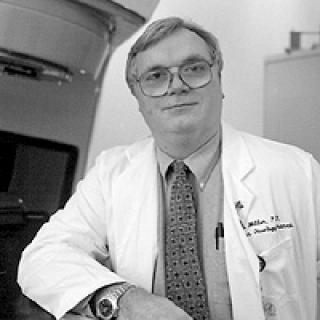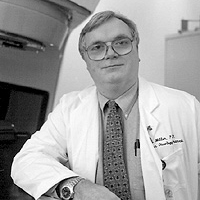
Robert William Miller, Ph.D.
- Center for Cancer Research
- National Cancer Institute
- Building 10 - Hatfield CRC, Room B2-3661
- Bethesda, MD 20892
- 301-496-5457
- 301-480-5591
- rwmiller@mail.nih.gov
RESEARCH SUMMARY
Dr. Miller has extensive experience in radiation measurement and the development of dosimetry systems. His main research interests center on the development of radiation therapy equipment and computer modeling of radiation dose distributions and radiation transport, using both Monte Carlo as well as algebraic methods.
Areas of Expertise
Research
Radiation Physics, Dosimetry and Imaging
The technology available to deliver radiation therapy has advanced to the point that it is currently possible with external beams to deliver a radiation intensity distribution of any desired shape to a selected point in space with a spatial accuracy of +/-1 mm. The remaining problems from a physics standpoint are of target identification and tracking, that is, to properly define the target, to position it correctly with respect to the treatment fields, and to continually monitor its position during treatment delivery, correcting the treatment field in real-time to ensure proper target coverage.
Currently, target definition is anatomically based, using either CT or MR, to define a macroscopic target volume based on either changes in effective atomic number (CT) or in hydrogen content (MR) that are believed to be caused by the presence of carcinoma. The next stage in radiotherapy, however, will be to image a target area based on specific functionality, in addition to anatomical structure, using tools such as functional MRI, MRS, SPECT, PET, or EPRI. This ability will depend on very sophisticated image fusion technology to register and stack the differing imaging methodologies so that a physician can combine selected studies in order to design a treatment plan that selectively targets those regions of the tumor that are most critical to control.
The next level of sophistication will involve real-time image and dose gating. This will involve the use of anatomical information acquired in real-time during radiotherapy, using either ultrasound or electronic portal imaging to directly determine target motion. Image comparison can be used to gate the treatment and determine the direction of target motion, generating signals to reposition either the treatment field (by shifting leaf positions of a multi-leaf collimator) or the patient (by shifting the treatment table). Once a correction is applied, an imaging dose is generated to verify correct target position prior to continuing treatment. The tools necessary to accomplish this include: (1) a sophisticated image fusion program necessary for registering the results of various imaging modalities, (2) a treatment planning system which displays image stacks in the desired viewing plane and for rapid recalculation of the dose distribution from real-time image data, and (3) small fiberoptic dosimeter probes capable of being used in vivo and multiplexed into a readout system that measures dose in real-time. These will be interfaced with a state-of-the-art linear accelerator equipped with dynamic multi-leaf collimation, amorphous silicon imaging technology, and a gated-dose control mechanism capable of millisecond response, in order to achieve image-controlled radiotherapy. The sophistication of rendering multiple image volumes will also be necessary to ensure accurate treatment delivery and tissue sampling for MR-guided prostate brachytherapy using high dose-rate (HDR) remote controlled afterloader technology.
The Physics Section will have a primary role in developing MR compatible treatment accessories and will provide the computer technology necessary for accurate tissue biopsy under MRI/MRS guidance, for calculation of the radiation dose at biopsy sites as well as the source locations and residence times required for the optimum dose distribution, and for real-time, in-vivo dose verification of treatment delivery. Novel treatment strategies must also be explored when they promise an increased dose to the target with reduced normal tissue exposure. One such avenue is the use of radiolabeled antibodies, either as an adjunct to conventional external beam radiotherapy or as a potential replacement. The Physics Section will be responsible for source selection and for the imaging required to determine biological distribution and organ distribution, and retention of the selected antibody. The Physics Section also is engaged in a partnership with the Naval Research Laboratory to develop Optically Stimulated Luminescent (OSL) dosimeters for dose verification. Single fiber point dosimeters small enough for implantation or insertion in a catheter have already been developed and are undergoing clinical trials. These dosimeters will supplant existing detector methodology such as TLDs and diodes for routine clinical measurement. Additionally, a two-dimensional OSL film is being developed to supplant photographic and radiochromic film for dosimetry QA purposes.
Our collaborators include Marie Ann Descalle, Christine Hartman-Siantor and Rosemary Walling, Lawrence Livermore National Laboratory; Michael Green and James Vucich, NIH; Alan Huston and Brian Justus, Naval Research Laboratory; and Thomas Fearon, Children's National Medical Center.
Publications
Brain tumor segmentation using holistically nested neural networks in MRI images
Output factor comparison of Monte Carlo and measurement for Varian TrueBeam 6 MV and 10 MV flattening filter-free stereotactic radiosurgery system
GPU-based relative fuzzy connectedness image segmentation
Patient-specific CT dosimetry calculation: a feasibility study
Comparison of intensity-modulated radiotherapy, adaptive radiotherapy, proton radiotherapy, and adaptive proton radiotherapy for treatment of locally advanced head and neck cancer
Biography

Robert William Miller, Ph.D.
Dr. Miller received his undergraduate degree in physics in 1971 and his M.S. in radiation health in 1974, both from the University of Pittsburgh. He received his Ph.D. in radiological sciences from the George Washington University in 1998. He joined the NCI in 1981 and has board certification in therapeutic radiological physics. He has been acting chief of the Radiation Physics and Computer Automation Section since 1997.
